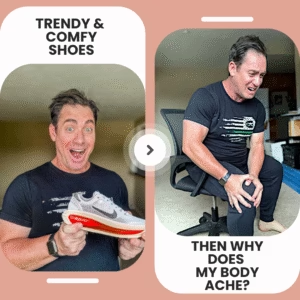
He thought the solution was simple: buy the most cushioned shoes on the market. Everyone swore that Hokas were the answer to joint pain, so he invested in a pair. At first, the soft landing felt like walking on clouds. But within weeks, his knees ached, his hips tightened up, and every workout left him frustrated. Stretching didn’t help. Rest didn’t help. The pain just wouldn’t go away.
Then came the epiphany. The problem wasn’t his body—it was his shoes.
The Hidden Problem With Modern Shoes
Here’s the truth: nearly every shoe you see on store shelves—Nike, Adidas, Brooks, Hoka, On Cloud, even your fancy dress shoes—has one thing in common. They’re designed for style or performance metrics, not long-term foot health.
That design flaw has a ripple effect. Narrow toe boxes squash your toes together, creating deformities and limiting balance. High heel-to-toe drops tilt your body forward, forcing your hips and spine into unnatural positions. Thick stack heights and “max cushion” soles numb the natural feedback your feet need to stabilize your body.
The result? Nagging pain in your knees, hips, or back that you’ll never connect to your footwear—until you know better.
The Switch That Changes Everything
When he finally swapped his trendy shoes for a pair built on foot health principles—wide toe box, minimal heel-to-toe drop, stack height appropriate for the activity—something incredible happened. The pain disappeared. His stride felt smoother, more natural. Performance improved almost immediately.
It wasn’t his body failing him. It was his shoes holding him back.
What Makes Good Footwear?
If you’re tired of pain and ready to maximize your performance, here’s what to look for in your next pair of shoes:
- Toe Splay: Your toes should be able to spread naturally, just like they do barefoot. Wide toe boxes prevent bunions and balance issues.
- Heel-to-Toe Drop: Aim for zero drop or as close as possible. Elevated heels force compensations in your hips and spine.
- Stack Height: Match it to the activity. Low stack for lifting or everyday wear; higher stack for pounding pavement.
- Arch Support: Use only as needed. Natural strength is best, but hard surfaces sometimes require external support.
Click for more information on what makes good footwear.
Bottom Line
Your body isn’t broken. Your workouts aren’t failing you. Your shoes are.
Choose footwear that respects your anatomy, and you’ll not only eliminate pain—you’ll unlock better performance, more energy, and a healthier future.
Stop letting your shoes sabotage your fitness. Start walking, running, and training in a way that lets your body work the way it was designed to.